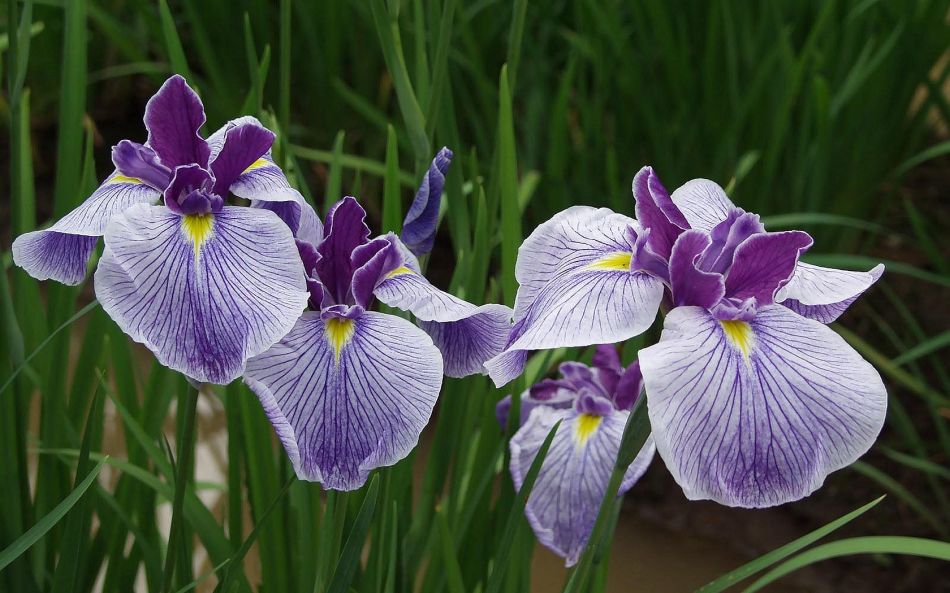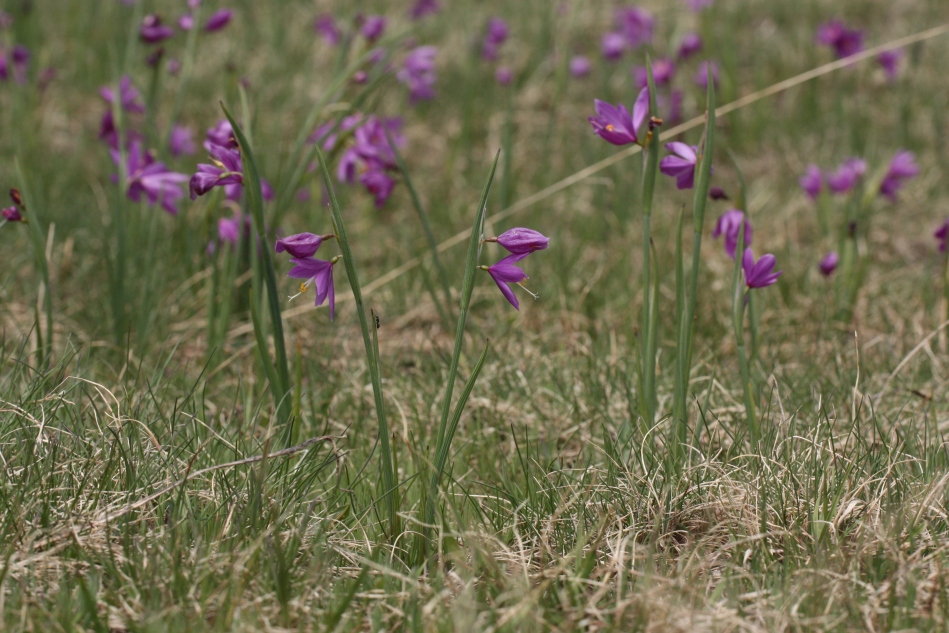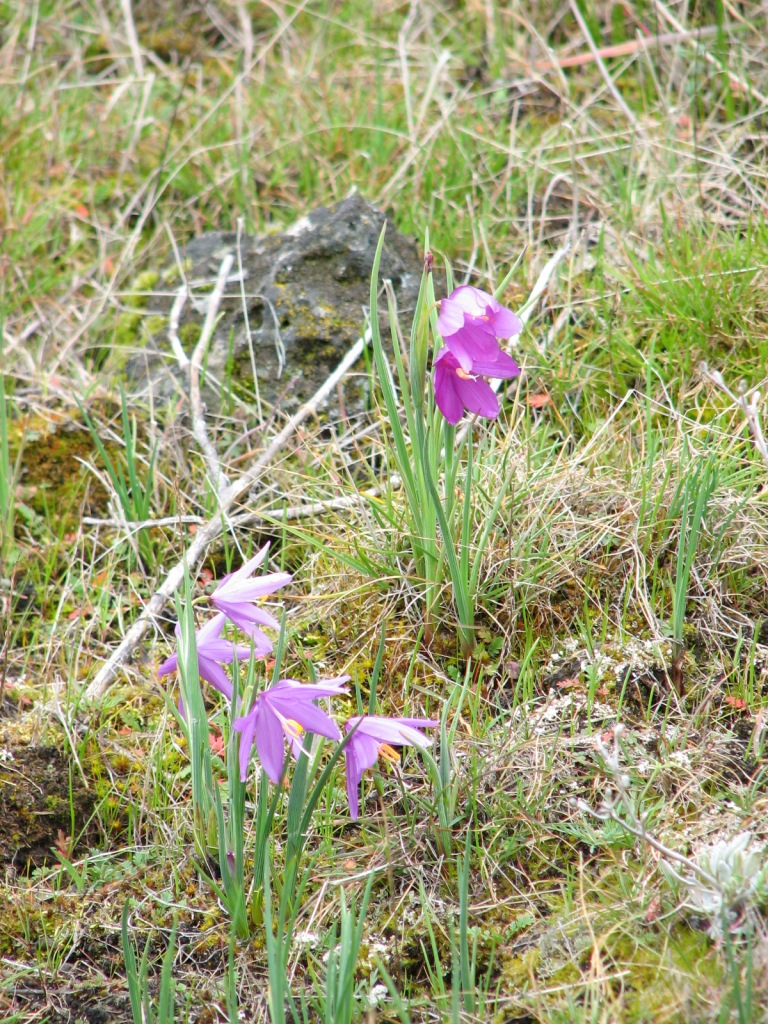Get Your Soil Ready for Spring 🌱🌱 3 Steps to Hit the Ground Running!

Related
Composting ~ How to make your own Compost Bins

https://auntiedogmasgardenspot.wordpress.com/2013/04/08/compostingandbins/

Flower Bulbs : How to Thin Iris Bulbs ~ Iris Plant Care Guide
How to Divide Bearded Irises
Bearded irises tend to become crowded every two to three years and cease to produce good blooms. Division and transplanting allows the clump to rejuvenate and also provides a way to multiply your iris. It isn’t difficult to do, but it is important to do it at the right time of year to ensure that the iris benefits most from the division.
The best time to plant or transplant iris is after flowering through August. Iris are one of the few perennials to transplant during the hottest part of the year. Established plantings of iris should be divided every 3-4 years or whenever the clump becomes crowded or when flowering decreases.
How to Plant and Grow Bearded Iris (contributions by Jim Morris)
Bearded irises are relatively easy garden plants to grow and will give good results with a minimum of care, but like all plants, the better the culture the more magnificent the display. The following instructions are easy to implement and should lead to beautiful iris blooms year after year.
Iris Variety and Plant Care Guide Here @ Auntie’s
Brunnera ~ Siberian bugloss Plant Care Guide
Brunnera macrophylla (Siberian bugloss, great forget-me-not, heartleaf) is a species of flowering plant in the family Boraginaceae, native to the Caucasus. It is a hardy, rhizomatous, herbaceous perennial, that can reach from 12 to 18 inches (30 to 45 cm) in height, and carries basal, simple cordate leaves on slender stems. Sprays of small blue flowers, similar to those seen in the related forget-me-nots, are borne from mid-Spring, and bloom for eight to ten weeks.
The plant is valued as groundcover in shady areas, and has clumps of large heart-shaped leaves of about six inches (15 cm); these usually have white or cream markings, and are present all season. Plants are happy in any shady area that stays relatively moist. It often self-seeds, appearing around the garden in other places. Clumps may be easily divided in early fall.
The Latin specific epithet macrophylla means “larger-leaved”.
This plant and the variegated cultivars ‘Hadspen Cream’ and ‘Jack Frost’ have gained the Royal Horticultural Society’s Award of Garden Merit.
Herbaceous Perennial Flower
Also known as Siberian Bugloss , False Forget Me Not
Brunnera macrophylla
Boraginaceae Family
Synonym: Anchusa myosotidiflora
Perfect for moist woodland settings, dainty intensely blue flowers rise above heart shaped, dark green leaves on this spring-blooming perennial.

A superb introduction, forming a clump of heart-shaped silver leaves, delicately veined with mint green. Sprays of bright blue Forget-me-not flowers appear in mid to late spring. This is a choice collector’s plant, but an easy-to-grow perennial that performs well in all but the driest of shady conditions. Excellent for the woodland garden. ‘Jack Frost’ handles more direct sun that most other variegated types of Brunnera, though in hot-summer regions some afternoon shade is recommended to prevent leaf scorch. Selected as the 2012 Perennial Plant of the Year by the Perennial Plant Association.
Brunnera Plants: How To Plant Brunnera Siberian Bugloss
By Becca Badgett
Blooming, growing brunnera is one of the prettiest plants to include in the shady garden. Commonly called false forget-me-not, petite blooms compliment attractive, glossy foliage. Brunnera Siberian bugloss is also called heartleaf brunnera because of the shape of its leaves. It is an herbaceous perennial, dying back in winter.
About Brunnera Plants
The light blue blooms of brunnera plants rise above the leaves of various cultivars. Brunnera plants have leaves that are glossy green or in variegated hues of gray, silver or white, such as the popular cultivar ‘Jack Frost.’ Brunnera Siberian bugloss blooms in early to mid spring.
When growing brunnera, locate the plant in part to full shade, in well-drained soil that can be kept consistently and lightly moist. Brunnera plants don’t do well in soil that dries out, neither will they flourish in soggy soil.
Grass Widows ~ Wildflowers ~ Purple Eyed Grass
Olsynium douglasii (syn. Sisyrinchium douglasii, Sisyrinchium grandiflorum) is a flowering plant, commonly known as grasswidows, in the genus Olsynium, native to western North America from southern British Columbia south to northern California, and east to northwest Utah. It is the only species in the genus Olsynium in North America, the remaining 11 species being from South America. It was formerly treated in the related genus Sisyrinchium.
It is a perennial herbaceous bulbiferous plant growing to 10-40 cm tall. The leaves are slender linear, 10-30 cm long and 1.5-3 mm broad. The flowers are bell-shaped, 15-25 mm long, with six purple tepals.
There are two varieties:
Olsynium douglasii var. douglasii. Coastal western North America. Flower filaments with a narrow base.
Olsynium douglasii var. inflatum. Interior western North America. Flower filaments with an inflated base.
http://en.wikipedia.org/wiki/Olsynium_douglasii
Grass Widow (Olsynium douglassii>) is an early-blooming, perennial plant of open woodlands and rocky meadows that are wet in early spring but later dry up.
The satiny, reddish-purple to pinkish-purple flowers are up to about 1.5 in (4 cm) across and the whole plant is less than 12 in (30 cm) tall.
Hundreds of these purple flowers can cover a meadow, creating a beautiful scene as they shimmer in the breeze.
Other common names for this plant are Satin Flower and Douglas’ Blue-Eyed Grass. It has also had a different genus: Sisyrinchium
The species name douglasii honors David Douglas, a botanist who was an early explorer of the Pacific Northwest. You might have heard of Douglas Fir? Well, that was another plant named after David Douglas.
Grass Widow is in the iris family, Iridaceae, which includes only a handful of species in our region. One that is probably familiar to many northwesterners is Oregon Iris(Iris tenax).
http://www.wildpnw.com/2011/03/30/wildflower-wednesday-grass-widow/#.VN-swubF9jE
The Iris Family in the Columbia River Gorge of Oregon and Washington]
Douglas’ Grasswidow, Grass Widow, Satin-flower
http://science.halleyhosting.com/nature/gorge/3petal/iris/grasswidow.htm
Satin flower, Grass widow; Olsynium douglasii
http://sanjuanislandtrails.org/plantsw/plant-gallery/attachment/satinflowers0071/
Grass Widows Gallery
http://www.lensjoy.com/gallery/73.htm
How to Plant a Spirea Bush ~ Plant Care Guide
Spiraea /spaɪˈriːə/, is a genus of about 80 to 100 species of shrubs in the family Rosaceae. They are native to the temperate Northern Hemisphere, with the greatest diversity in eastern Asia.
The genus formerly included the herbaceous species now segregated into the genera Filipendula and Aruncus; recent genetic evidence has shown that Filipendula is only distantly related to Spiraea, belonging in the subfamily Rosoideae.
Spiraea plants are hardy, deciduous-leaved shrubs. The leaves are simple and usually short stalked, and are arranged in a spiralling, alternate fashion. In most species, the leaves are lanceolate (narrowly oval) and about 1 to 4 inches (2.5 to 10.2 cm) long. The leaf margins are usually toothed, occasionally cut or lobed, and rarely smooth. Stipules are absent.
The many small flowers of Spiraea shrubs are clustered together in inflorescences, usually in dense panicles, umbrella-like corymbs, or grape-like clusters. The radial symmetry of each flower is five-fold, with the flowers usually bisexual, rarely unisexual. The flowers have five sepals and five white, pink, or reddish petals that are usually longer than the sepals. Each flower has many (15 to 60) stamens. The fruit is an aggregate of follicles.
Species
- Spiraea affinis
- Spiraea alaskaense
- Spiraea alba – narrow-leaved meadowsweet, pale bridewort
- Spiraea albiflora
- Spiraea amoena
- Spiraea arcuata
- Spiraea baldschuanica
- Spiraea bella
- Spiraea betulifolia – white meadowsweet
- Spiraea blumei
- Spiraea calcicola
- Spiraea cana
- Spiraea canescens – Himalayan spiraea
- Spiraea cantoniensis – Reeve’s spiraea
- Spiraea chamaedryfolia – elm-leaf spiraea, germander meadowsweet
- Spiraea crenata
- Spiraea decumbens
- Spiraea douglasii – Douglas’ spiraea, steeplebush
- Spiraea gemmata
- Spiraea henryi
- Spiraea hypericifolia – Iberian meadowsweet
- Spiraea japonica – Japanese spiraea
- Spiraea lobata
- Spiraea longigemmis
- Spiraea media – Russian spiraea
- Spiraea micrantha
- Spiraea miyabei
- Spiraea mollifolia
- Spiraea nervosa
- Spiraea nipponica
- Spiraea prunifolia – bridal-wreath spiraea
- Spiraea pubescens
- Spiraea rosthornii
- Spiraea salicifolia – bridewort, willowleaf meadowsweet
- Spiraea sargentiana
- Spiraea septentrionalis – northern meadowsweet
- Spiraea splendens – rose meadowsweet
- Spiraea stevenii – beauverd spirea
- Spiraea thunbergii – Thunberg’s meadowsweet
- Spiraea tomentosa – hardhack, steeplebush
- Spiraea trichocarpa
- Spiraea trilobata – Asian meadowsweet
- Spiraea veitchii
- Spiraea virginiana – Virginia spiraea
- Spiraea wilsonii
- Spiraea yunnanensis
Hybrids
There are also numerous named hybrids, some occurring naturally in the wild, others bred in gardens, including several important ornamental plants:
- Spiraea × arguta (S. × multiflora × S. thunbergii) – garland spiraea
- Spiraea × billiardii (S. douglasii × S. salicifolia) – Billiard’s spiraea
- Spiraea × blanda (S. nervosa × S. cantoniensis)
- Spiraea × brachybotrys (S. canescens × S. douglasii)
- Spiraea × bumalda (S. japonica × S. albiflora)
- Spiraea × cinerea (S. hypericifolia × S. cana)
- Spiraea × conspicua (S. japonica × S. latifolia)
- Spiraea × fontenaysii (S. canescens × S. salicifolia)
- Spiraea × foxii (S. japonica × S. betulifolia)
- Spiraea × gieseleriana (S. cana × S. chamaedryfolia)
- Spiraea × macrothyrsa (S. douglasii × S. latifolia)
- Spiraea × multiflora (S. crenata × S. hypericifolia)
- Spiraea × notha (S. betulifolia × S. latifolia)
- Spiraea × nudiflora (S. chamaedryfolia × S. bella)
- Spiraea × pikoviensis (S. crenata × S. media)
- Spiraea × pyramidata (S. betulifolia × S. douglasii) – pyramid spiraea
- Spiraea × revirescens (S. amoena × S. japonica)
- Spiraea × sanssouciana (S. japonica × S. douglasii)
- Spiraea × schinabeckii (S. chamaedryfolia × S. trilobata)
- Spiraea × semperflorens (S. japonica × S. salicifolia)
- Spiraea × vanhouttei (S. trilobata × S. cantoniensis) – Van Houtte’s spiraea
- Spiraea × watsoniana (S. douglasii × S. densiflora)
http://en.wikipedia.org/wiki/Spiraea
~~~~~~~~~~~~~~~~~~~~~~~~~~~~~~~~~~~~~~~~~~~~
How to Plant a Spirea Bush ~ by Caryn Anderson
http://homeguides.sfgate.com/plant-spirea-bush-24222.html
 Adding a 2-inch layer of mulch helps discourage weeds from growing.
Adding a 2-inch layer of mulch helps discourage weeds from growing.
Spireas (Spiraea) fill the landscape with cascading clusters of flowers that bloom in spring and summer. These deciduous shrubs grow to heights and spreads of 2 to 10 feet, depending on the variety. They are hardy in Sunset Climate Zones 14 through 17. Spireas flourish in coastal and inland climates and are one of easiest types of flowering shrubs to grow, since they require minimal maintenance and adapt to a range of growing conditions.
Find a planting area that has well-draining soil, receives full to partial sun exposure and has enough space to accommodate the spirea’s projected mature size. Take spacing into consideration. Plan to allow 2 to 15 feet between plants, allowing more space between larger varieties of spirea.
- Dig a hole that is as deep as the spirea’s root ball and at least twice as wide to allow the roots to spread out. In general, you do not need to add anything to the soil or test its pH since spireas adapt to most types of soil. If the soil is very low in organic materials, mix about 1 inch of compost in with the garden soil while planting.
- Remove the plant from its container, gently loosening any roots that are wound tightly around the root ball. Place it upright in the hole and fill it in halfway with soil. Water the hole thoroughly, saturating the ground to remove any air pockets that may later damage the spirea’s roots. Wait until the water is absorbed to fill the hole completely with soil and water thoroughly again.
- Create a ring around the spirea’s hole, mounding soil 2 to 3 inches high to help hold water in the planting area. Distribute a layer of mulch about 2 inches thick around the planting area beyond the ring that you created. After the plant’s first season, remove the ring and place mulch closer to the plant.
- Water plants regularly throughout the growing season, adding an average of 1 inch of water weekly. Where you live may dictate how frequently you have to water your plants. For example, gardeners in coastal areas usually have sandy soil. Sandy soil drains faster than other types of soil, making it necessary for gardeners to water more frequently.
Things You Will Need
Spade
Garden tiller (optional)
Compost (optional)
Mulch
Planting times are flexible. Gardeners should plant spireas in spring or fall to allow young plants time to become established before summer.
About the Author
Caryn Anderson has been writing professionally since 2007. She specializes in a variety of subjects, including food and healthy recipes, pets and health. She is an avid gardener and travel enthusiast. Anderson holds her Bachelor of Science in communication studies from New York University.
Photo Credits
Jupiterimages/Photos.com/Getty Images
~~~~~~~~~~~~~~~~~~~~~~~~~~~~~~~~~~~~~~~~~~~~~~~
Care of Spirea ~ by Jackie Carroll
Spirea comes in a wide range of sizes and types, each with its own uses in the landscape. Small varieties, such as the 1.5-foot-tall Spirea japonica, work well as neat, rounded ground covers. Mid-sized plants, including most varieties of S. x cineria show best in foundation plantings and shrub borders. If you’re looking for an informal hedge or specimen plant, choose S. nipponica, S. prunifolia or S. vanhouttei, which grow to between 5 and 9 feet tall. Spring-blooming spireas generally have white flowers, while summer-blooming types usually bloom in shades of pink or red.
http://homeguides.sfgate.com/care-spirea-21670.html
Spirea ~ Spireas are small to medium sized deciduous shrubs that produce cascades of flowers in spring and summer.
http://www.garden.org/plantguide/?q=show&id=2103
Growing Spirea Shrubs: Information On How To Care For Spirea Bushes
http://www.gardeningknowhow.com/ornamental/shrubs/spirea/growing-spirea-shrubs.htm
Crocus vernus flower time lapse ~ Crocus Plant Care Guide
Crocus ~ Plant Care Guide

A sure sign of spring, crocuses have low-growing, colorful, cup-shaped flowers that are a welcome sight in garden beds and lawns.
About This Plant
Mass plantings of colorful crocuses herald the start of spring, sometimes poking their flowers right up through the snow. Because the plants flower so early, crocuses adapt well to planting in lawns and will multiply over time to cover large areas. Select varieties that mature at different times to extend the bloom season. Flower colors include blue, violet, striped, yellow, and white, and height ranges from 3 to 6 inches. While most crocus flower in spring, the saffron crocus is a fall-flowering crocus that is planted in spring.
Read in Full Here @ Auntie Dogma’s
Astilbe ~ False Spirea Plant Care Guide ~ Varieties
Astilbe /əˈstɪlbiː/[1] is a genus of 18 species of rhizomatous flowering plants, within the family Saxifragaceae, native to mountain ravines and woodland in Asia and North America.[2] Some species are commonly known as false goat’s beard, and false spirea.
These hardy herbaceous perennials are cultivated by gardeners for their large, handsome, often fern-like foliage, and dense, feathery plumes of flowers. They are widely adapted to shade and water-logged conditions, hence they are particularly associated with pond-side planting. They also tolerate clay soils well. Numerous hybrid cultivars have been raised. Flowers of at least some astilbe species have a strong and pleasant aroma.
Species of Astilbe include:
- Astilbe biternata (Vent.) Britt.
- Astilbe chinensis (Maxim.) Franch. & Sav.
- Astilbe crispa (Arends) Bergmans
- Astilbe grandis Stapf ex E. H. Wilson
- Astilbe japonica (C.Morren & Decne.) A.Gray
- Astilbe longicarpa (Hayata) Hayata
- Astilbe macroflora Hayata
- Astilbe microphylla Knoll
- Astilbe platyphylla H. Boiss.
- Astilbe rivularis Buch.-Ham. ex D. Don
- Astilbe rivularis var. angustifoliolata H. Hara
- Astilbe rivularis var. myriantha (Diels) J. T. Pan
- Astilbe rubra Hook. f. & Thomson
- Astilbe sikokumontana Koidz.
- Astilbe simplicifolia Makino
- Astilbe thunbergii (Siebold & Zucc.) Miq.
- Astilbe thunbergii var. congesta H. Boissieu
- Astilbe thunbergii var. fujisanensis (Nakai) Ohwi
- Astilbe thunbergii var. hachijoensis (Nakai) Ohwi
- Astilbe thunbergii var. kiusiana Hara
- Astilbe thunbergii var. longipedicellata Hatus.
- Astilbe thunbergii var. okuyamae (Hara) Ohwi
- Astilbe thunbergii var. shikokiana (Nakai) Ohwi
- Astilbe thunbergii var. terrestris (Nakai) Ohwi
Cultivar Groups
Commonly accepted cultivar groups are:
- Astilbe Arendsii Group
- Astilbe Crispa Group
- Astilbe Japonica Group
- Astilbe Simplicifolia Group
The following varieties and cultivars have gained the Royal Horticultural Society‘s Award of Garden Merit:-
******

Astilbe @ Old Farmer’s Almanac
Botanical name: Astilbe
Plant type: Flower
USDA Hardiness Zones: 3, 4, 5, 6, 7, 8, 9
Sun exposure: Full Sun, Part Sun
Soil type: Loamy
Flower color: Red, Pink, White
Astilbe is a perennial with beautiful, showy flowers atop glossy, fern–like foliage. Its flower clusters vary in size from 6 inches to 2 feet and its height varies from 6 inches to 5 feet, depending on the type. Astilbes are easy to care for and will live for a long time in your garden. Their only requirement is moisture.
Planting
- You can plant astilbe seeds, but they are short–lived and difficult to germinate. It is easier to plant the divisions from other astilbe plants.
- Plant the divisions in the spring or fall about 1 to 3 feet apart, depending on the type. If you are planting bare-root plants, make sure the holes are twice as wide as the plants and 4 to 6 inches deep. Place the plants so that the crown is 1 to 2 inches below the ground level. Cover the roots with soil and press firmly.
- Make sure to plant the divisions in consistently moist, humus-rich soil. Dry soil can be fatal to your plants. If you like in the North, you can plant them in full sun as long as they have moist soil. To prolong the foliage, provide shade from hot afternoon sun. In warmer regions, you must plant astilbes in light to partial shade. Astilbes can grow in deep shade but will not flower as much.
Care
- Remember to regularly check your astilbes to make sure they are moist. Water accordingly.
- Astilbes spread quickly and form broad clumps. Their crowns often rise above the soil as they grow, so make sure to cover them with humus-rich soil or lift and replant the clumps.
- Your astilbes will benefit from a balanced organic fertilizer applied in the spring.
- Be sure to divide the overgrown clumps every 3 to 4 years in the spring. You can either replant the divisions immediately or put them in pots to be planted out in the early summer when they are re-established.
- Removing the flower heads will not promote continued flowering.
Pests
- Tarnished plant bug
- Powdery mildew
- Bacterial leaf spots
Recommended Varieties
- Fanal, for its dark green foliage and dark crimson flowers
- Irrlicht, for its dark green foliage and elegant white flowers
- Venus, for its bright green foliage and bright pink flowers
Special Features
- Attracts Butterflies
****************

See Also ….
Native Plant Database
Astilbe @ National Gardening Assoc.
Astilbe Planting Guide @ Easy to Grow Bulbs

Heuchera Plant Care Guide and Varieties (Coral bells)
Heuchera Plant Care
Overview
Heuchera, also known as coral bells, alum root or Saxifragaceae, is an herbaceous perennial plant commonly grown as ground cover available in a wide variety of colors, sizes and textures. The name coral bells reflects the appearance of the ornamental flowers, though the semi-evergreen foliage is an attractive feature in itself. Heuchera, native to North America, thrives in USDA hardiness zones 3 through 11 and often grows with little to no care in most temperate regions.
Site and Soil
Plant your heuchera in a location with moist, well-drained, fertile soil that receives partial shade throughout the day. The plant tolerates full sun or full shade, but partial shade yields the best results. A soil amendment of organic compost increases the drainage and fertility of the soil to adequate levels. Heuchera grows well and provides a nice accent in a location near other herbaceous perennials. Spacing separate plantings 10 to 16 inches apart provides plenty of room for growth.
Watering
Watering once every seven days will prevent the soil from drying out completely. Heuchera needs consistently moist soil to thrive, especially in hotter climates. To reduce the risk of foliar disease, heuchera requires watering during the early morning so any excess moisture can evaporate before evening. Drip irrigation effectively delivers moisture directly to the soil, further reducing the plant’s vulnerability to disease.
Mulching
Spreading a 2-inch layer of mulch over the soil surrounding heuchera helps insulate the soil during winter and improve moisture retention. About 3 inches of space between the plant’s crown and the mulch allows air circulation, which prevents rotting and disease. Replenishing the mulch throughout the year ensures proper winter protection and hinders the establishment of competitive weeds.
Fertilizing
Apply a 10-10-10 NPK fertilizer monthly during the spring and summer months at half the rate recommended by the manufacturer’s instructions. Watering the soil before and after applying prevents root burn and dissolves the fertilizer, releasing the nutrients. Heuchera requires minimal nutrients and does not require fertilization during the fall or winter months.
Dead-Heading
Removal of faded heuchera flowers extends the blooming season and encourages the plant to form additional blossoms. This process, known as dead-heading, also prevents the plant from producing seeds and invading other portions of the lawn or garden. Severing the flower stems at their point of origin minimizes damage to the plant and makes re-blooming less stressful.
**************
From Wikipedia …
The following cultivars have gained the Royal Horticultural Society‘s Award of Garden Merit:-
- ‘Blackbird’[3]
- ‘Burgundy frost’[4]
- ‘Can-can’[5]
- ‘Chocolate veil’[6]
- ‘Fireworks’[7]
- ‘Magic wand’[8]
- ‘Molly bush’[9]
- ‘Purple petticoats’[10]
- ‘Quilter’s joy’[11]
- ‘Raspberry regal’[12]
- ‘Sashay’[13]
- ‘Smokey rose’[14]
Selected species
- Heuchera abramsii – San Gabriel Alumroot
- Heuchera alba – White Alumroot
- Heuchera alpestris – San Bernardino Alumroot
- Heuchera americana – American Alumroot
- Heuchera brevistaminea – Laguna Mountain Alumroot
- Heuchera x brizoides – Coral Bells (Hybrids)
- Heuchera cespitosa – Tufted Alumroot
- Heuchera chlorantha – Green-flowered Alumroot
- Heuchera cylindrica – Roundleaf Alumroot, Lava Alumroot
- Heuchera duranii – Duran’s Alumroot
- Heuchera elegans – Urnflower Alumroot
- Heuchera hirsutissima – Shaggy-haired Alumroot
- Heuchera maxima – Island Alumroot, Jill-of-the-Rocks
- Heuchera merriamii – Merriam’s Alumroot
- Heuchera micrantha – Crevice Alumroot, Smallflower Alumroot
- Heuchera parishii – Mill Creek Alumroot
- Heuchera parvifolia – Small-flowered Alumroot
- Heuchera pilosissima – Seaside Alumroot, Parish’s Alumroot
- Heuchera pubescens – Appalachian heuchera
- Heuchera pulchella – Sandia Alumroot
- Heuchera richardsonii – Richardson’s Alumroot
- Heuchera rubescens – Pink Alumroot
- Heuchera sanguinea – Coral Bells
- Heuchera villosa – Hairy Alumroot, Maple-leaved Alumroot
- Heuchera wootonii – Wooton’s Alumroot
Also … Native Plant Database ~ Here

Easy Garden Craft for Kids: Root and Grow Your Own Pussy Willow Bush ~ Plant Care Guide
Rooting and growing a Pussy Willow bush is a great, really easy garden craft you can do with your kids. This garden craft is best done around the time the Pussy Willow catkins begin to open.
For this craft, you will need:
A Pussy Willow twig.
A clear vase or a jelly jar.
Water.
To start the craft, procure the twig from a pussy willow bush. The twig should come from a reliable pussy willow plant cultivar as opposed to coming from an unknown pussy willow bush growing in the wild. Do you have a cultivar of Pussy Willow that is not protected by a plant patent growing in your backyard? You can also ask a friend or neighbor for a twig from their pussy willow bush. Another way is to glean a twig from a bush growing over the sidewalk. Pussy Willow plants grow in the wild but you take potluck because wild pussy willow bushes vary in bloom performance. If the plant is in bloom, you can get an idea of the plant’s potential.
You may have to purchase the Pussy Willow. If you regularly buy flowers, you can purchase a bouquet that includes pussy willow from a florist. If you know someone who works in a flower shop, you can ask for the scraps from the pussy willow twigs that are used in floral arrangements. Make sure the twig is still fresh and hasn’t been allowed to dry up. And as a last resort, you can buy a pussy willow bush from a garden center. But that kind of defeats the purpose of this craft, which is to grow a Pussy Willow bush from a rooted twig.
Procure a vase in which to root the craft. The reason I recommend using a clear container is because that way, your child can see the roots as they develop and grow without having to pull the twig from the vase. The kids will find watching the roots grow very fascinating. A Jelly jar can also make a good vase by simply removing the label.
If the cut edge of the pussy willow twig has been exposed, give it a fresh cut. Once a stem cut is allowed to air-dry for an extended time, it will seal off and inhibit the ability of the stem to take in water. Put water in the vase or jelly jar and insert the twig. Then all you have to do is make sure to check the water daily. You will need to refill the water every few days and change the water should the water get cloudy. Should the cloudy water be left, the roots of the plant will usually start to rot.
When the roots start to grow little rootlets, then it’s time to plant the Pussy Willow plant. When the pussy willow bushes growing outside begin to grow leaves, the rooted plant can be safely transplanted outside. If it is still cold outside, the pussy willow plant will need to be grown inside the house until it is warm enough. I have not tried growing a rooted pussy willow cutting in the house, so I am not sure how well that would work. But if you have easy access to a Pussy willow plant, you can always pick another twig from the plant and start over should the craft fail. Otherwise, early spring would be the optimum time to do this garden craft.
Provide initial protection for the plant from winds and on freezing nights. Provided the outdoor trees are starting to leaf, the rooted plant will only need a week to “harden off” and get used to the cold. The pussy willow plant will also need to be watered twice a week the first year and during dry spells in following years.
You now have your own pussy willow plant. The plant should grow a couple feet the first year, then grow rapidly thereafter. For culture and care of Pussy Willow, you can refer to “Pussy Willow; Culture and Care of this Timeless Bush.” Although the first page describes the three varieties of Pussy willow, the article then goes into covering propagation, culture, and uses of the plant on the next two pages.
******************
See Also …
Native Plant Database
How to Grow and Care for Pussy Willow Trees
Growing Pussy Willows
How to Grow Pussywillows
Pussy willow is a name given to many of the smaller species of the genus Salix (willows and sallows) when their furry catkins are young in early spring. These species include (among many others):
- Goat willow or goat sallow (Salix caprea), a small tree native to northern Europe and northwest Asia.
- Grey willow or grey sallow (Salix cinerea), a small tree native to northern Europe
- American pussy willow (Salix discolor), native to northern North America.
Wild Blue Flax ~ Linum lewisii Plant Care Guide
Growing Flax: Tips For Flax Plant Care
 Image by Alan Levine
Image by Alan Levine
By Becca Badgett
The blue flax flower, Linum lewisii, is a wildflower native to California, but can be grown with a 70% success rate in other parts of the U.S. The cup shaped, perennial flax flower begins blooming in May and will continue through September, producing abundant flowers that last only a day. Flax may reach two feet or more at maturity.
The common flax plant, Linum usitatissimum, may be grown as a commercial crop in some areas. Flax is grown for the oil of its seeds, linseed oil, a protein source for livestock. Some commercial growers plant legumes as companions of the flax flower.
How to Grow Flax
Continued bloom of the flax flower is assured if conditions are right, due to self-seeding of this plant. A single planting in early spring provides an abundance of flax flowers in late spring and summer, but re-seeding by this perennial plant assures a continued mass of growing flax in the meadow or natural area.
Soil for planting flax should be poor and barren. Sand, clay and rocky soil all contribute to best growth of this plant. Soil that is too rich or organic may cause the plant to flop or die altogether as it is overtaken by other plantings that like organic soil.
Watering the growing flax plant is usually not necessary, as the plant prefers dry soil.
Tips on how to grow flax should contain a recommendation that the location for planting flax be chosen carefully. It is probably not appropriate for a formal or worked up garden as the soil will be too rich and most other plants in that setting will need water.
After planting, flax plant care is simple, as little maintenance is needed when growing flax. Tiny seeds germinate within a month of planting and produce a wealth of growing flax. The flax flower lasts only a day, but there seems to always be another to take its place.
If you would like to grow flax, consider seeding a meadow or open area with sunny spots. Seed sparingly until you see how the flax performs, as it has been known to escape cultivation and is considered a weed by some.
*****************************
See Also …..
Linum lewisii (Blue flax)
Flax Plant Care
Linum lewisii Prairie Flax Native Blue Flax Seed & Plants
BLUE FLAX PDF Plant Care Guide
Native Plant Database
Forsythia Plant Care Guide
Overview
The bright yellow blooms of the forsythia bush add a cheerful note to the gray scenery of early spring. The blooms appear in early April and last about two weeks. Once flowering is complete the bush will quickly become covered in bright green leaves. Forsythia are available in different varieties, some as small as 1 foot tall with others reaching heights of up to 10 feet. Forsythia bushes do best in full sun and soil that drains well, and they are resistant to most insects and diseases.
Step 1
Dig a hole that is two times as wide and the same depth as the container that the forsythia bush was purchased in.
Step 2
Add a 4-inch layer of organic compost to the planting hole. If the forsythia is growing in a plastic pot, gently squeeze the sides until the root ball slides out easily. If the bush is wrapped in burlap or other material, cut it free, taking care not to damage the roots.
Step 3
Place the root ball into the planting hole at the same level it was growing in its container. Replace the loosened soil and pat down to remove air pockets from around the roots.
Step 4
Soak the plant until the soil feels very moist, but not waterlogged. Continue to water whenever less than 1 inch of rain has fallen per week during the first growing season. After the roots are well-established, supplemental watering is only necessary during drought conditions.
Step 5
Fertilize once each year in late winter or early spring with a 10-10-10 fertilizer.
Step 6
Prune 1/4 of the largest branches back all the way to the ground every two years. Do not prune until flowering is complete because forsythia blooms on old wood.
*****************
See also ….
How to Grow and Care for a Golden Bells Forsythia Plant













































































Recent Comments